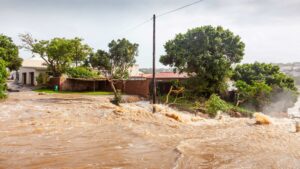Assam Floods. An Environmental Migrant Crisis
Assam, one of India’s most flood-prone states, continues to grapple with recurrent floods that displace millions and destroy livelihoods. As of last year, the Assam floods claimed 129 lives, including victims of landslides. The rising Brahmaputra River, expected to rise further due to continuous rainfall, affected over 2,500 villages. With vast areas submerged, these floods have left devastation in their wake, especially in rural areas dependent on agriculture.
Impact on Villages and Wildlife
More than 26 lakh people across 28 districts have been severely impacted. Assam, renowned for its biodiversity, lost numerous wild animals, including eleven rare one-horned rhinoceroses, underscoring the extent of environmental damage.
Villages like Patharsali in the Barpeta district were hit hard. Rafiqul, a local farmer, recounts how floods destroyed his crops and submerged his home, forcing his family and at least 150 others to move to relief camps. These makeshift shelters have become a temporary refuge for thousands, with basic weekly aid provided by the state government.
Climate Change Worsens Flood Risks
Assam’s lower Brahmaputra regions, such as Goalpara and Barpeta, are known climate change hotspots. The increased unpredictability of the monsoon has exacerbated the severity of these floods, making life on the riverbanks even more precarious. The lack of infrastructure and resources leaves residents vulnerable, forcing many to migrate in search of stability and better opportunities.
Many residents, like Mainul Haque from Dakshin Goudhani village, have faced repeated displacements. For Mainul, the floods forced him to seek work outside Assam, but recurring floods and environmental challenges continue to threaten his family’s livelihood. Experts suggest that migration from Assam is increasingly becoming a strategy for families to cope with the environmental challenges brought about by climate change.
Key Impacts of Assam Floods:
- 129 lives lost due to floods and landslides in 2021.
- 26 lakh people affected across 28 districts.
- 150+ families displaced from villages like Patharsali.
- 11 rare one-horned rhinos dead, highlighting the environmental toll.
The Role of the Assam Government
The Assam government faces growing pressure to address the dual challenges of climate-induced migration and economic strain. Relief camps struggle to accommodate all affected families, and as the floodwaters recede, many have nothing to return to. Community leaders emphasize the need for sustained relief efforts and policies that focus on both immediate support and long-term rehabilitation.
Professor Arupjyoti Saikia, an environmental historian, stresses that any development in Assam’s flood-affected areas requires a nuanced understanding of local ecology and historical factors. To truly help Assam’s flood migrants, a multi-pronged strategy that includes increased economic opportunities and awareness of the Brahmaputra’s climatic crisis is crucial.
As Assam continues to face the harsh realities of flooding, the government must work towards safeguarding vulnerable communities and mitigating the long-term effects of climate change on the region.
